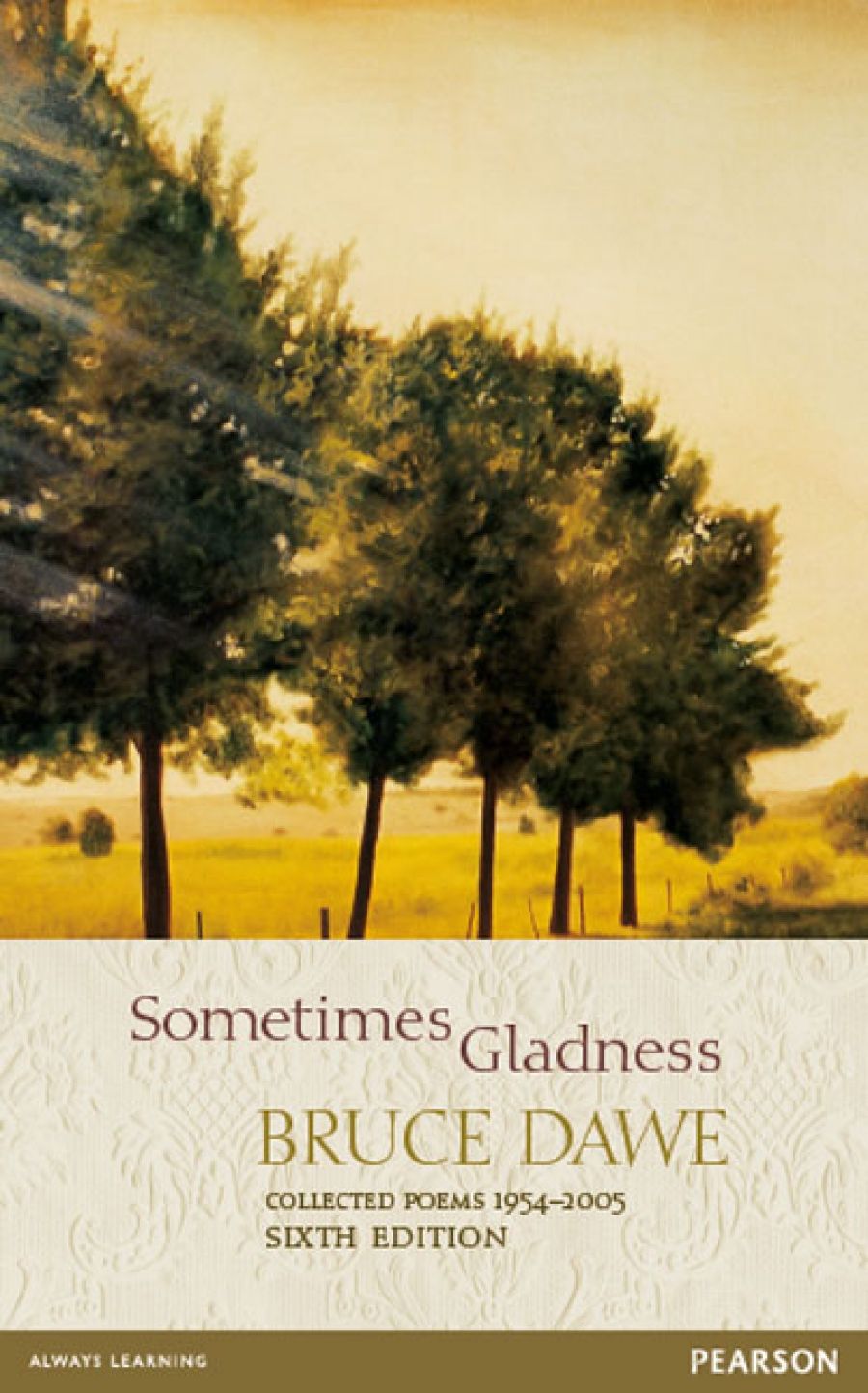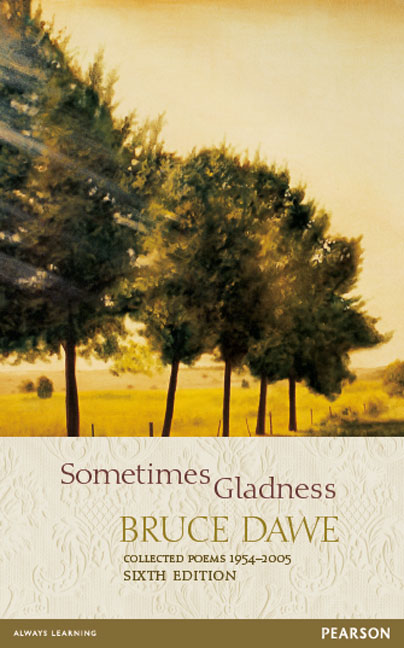
- Free Article: No
- Contents Category: Poetry
- Custom Article Title: Open Dawe
- Review Article: Yes
- Article Title: Open Dawe
- Online Only: No
- Custom Highlight Text:
People outside Australia are struck when Bruce Dawe is described as Australia’s most popular poet, just as people outside Ireland are struck when Paul Durcan or Brendan Kennelly is described as Ireland’s most popular poet. What about Les Murray, or Seamus Heaney? Are not these world-class poets ‘of the people’? Even more puzzling is that Dawe, like Durcan and Kennelly, is not necessarily an easy poet. Is their domestic popularity tied to how they seem to be ‘not for export’?
- Book 1 Title: Sometimes Gladness
- Book 1 Subtitle: Collected Poems 1954-2005
- Book 1 Biblio: Pearson, $29.95 pb, 337 pp, 0733978797
- Book 1 Cover Small (400 x 600):

- Book 1 Cover (800 x 1200):

This generous selection, stretching from 1954 to the midpoint of this decade, appeals with its provocative variety. Dawe is adept at assuming an attitude the reader supposes is easy to diagnose, and then twisting away from it, challenging us to supply an unanticipated extra thought. ‘Phase To Phase’ starts out as a bald denunciation of black armband history: ‘This is the collective race-guilt phase. / During this phase non-Aboriginals can generally expect to be insulted.’ But the poem’s attitudes are not trammelled by point-blank firmness:
Good sales and follow-up titles will bring on
the evil spirit of sophistication. Art must then
compete on terms of equality with art. In that phase
We will regain our freedom.
A privileging of ‘the aesthetic’ over ‘the political’? Yes. Yet these lines also show how a cultural trend, once it has crested, begins to ramify in unpredictable ways. Reflexivity not only cures the hypocrisies of white liberal guilt but also cures any tendency in the poem to excoriate these hypocrisies in overly strident terms. Once we realise that the ‘evil spirit of sophistication’ is evil only in the minds of those who wish to preserve a rigid simplicity, we view not just the attitudes satirised in the poem but the posture of the poem with scepticism. A modern Mary whose archangel is a controlling medical man tries ‘very hard / to imagine happiness’. We glimpse the happiness from which modern reproductive technologies have severed today’s Mary. But we also see how much determination is required even to dream of happiness. Thus there are times when the poet’s language comes to the rescue of poems with potentially easy targets. Dawe can scrutinise today’s world with more brio, as in ‘Busy, Busy, Busy’, with its sense of how proliferating special interests (the ‘Bring-back-Saxon England group’ or the ‘Mogul Restoration Party’) is concomitant with a postmodern ‘liberation’ of history from ordered, teleological sequence, as the Philistines, Minoans and even Neanderthals have revived followings. Readers will test their prejudices with respect to the cold eye Dawe casts around him. But the percipience of that eye is never in doubt.
In a chronological selection, the reader can start at the end, to see what the poet has been doing recently, and then flip back to the beginning to reconnoitre the earlier work. Early Dawe shows a similar mix of domesticity and social commentary, with the former holding its own here more than later on. ‘My Mother in Her Later Years’ bursts its realistic bounds: ‘Seven years dead, she still / clings phantasmagorically / to this proud irreducible concern.’ As poems about dying parents yield to poems about the poet’s angiograms and the death of his first wife, Gloria, and as Hungary in the 1950s yields to Myanmar and the Balkans in the 1990s, this leavening of the life-world by the unexpected sounds a continually pleasing note.
The poems from the 1950s seem transparent compared to the experimental vein of the generation of 1968, or even to the earliest work of Les Murray, but when Dawe is compared to R.D. FitzGerald and David Campbell, he seems stealthily innovative: not preoccupied by landscape or questing for an Australian vision, free of any stentorian gravity, not rigidly bound to rhyme or metre (although in ‘Dial WX 4500’, rhyme is used powerfully), and using an offhand colloquialism to render a world that the reader accepts well beyond the conventions of artificial poetic transaction. ‘The Last Romantics’ could be a poem of the Slessor generation in tone, but its American cowboy references mark it as written by somebody who grew up in the aftermath of World War II. When I started following Australian poetry, I confused Bruce Dawe and Bruce Beaver. This seems silly now; but sometimes Dawe’s work has a Beaver-like individuality and personal lyric feeling.
When we read ‘sometimes gladness’ as a phrase we unconsciously assume that this means more than fifty per cent gladness, resulting in a final gift of ‘a comfort and a joy’. But Dawe admits so much of the world’s ‘grievous steps’ in his verse that we might read the title more darkly as only sometimes gladness, pushing the ratio of joy below the fifty per cent threshold. It is because no single Dawe poem strains to grasp the totality of life that Dawe can summon a kaleidoscope of public and private feeling with poems that continually delight and surprise. He is an eligible popular poet because he is accessible in both language and attitude. Attitude is key: Dawe’s audience is generously included in the poems through his eschewal of an overly forceful poetic persona. (Note how many of these poems trail off in ellipses.) Dawe trusts, instead, in the modest and inconclusive, ‘The inadequate tin roof. / of words like these ...’


Comments powered by CComment